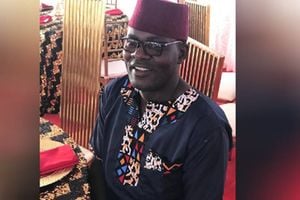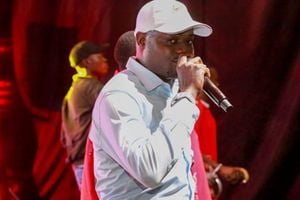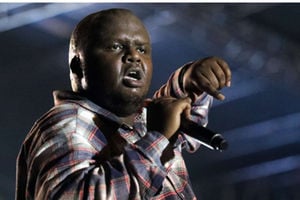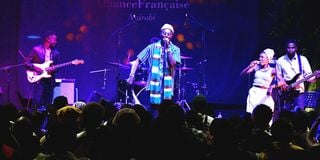
Coster Ojwang (center) performing on stage. FILE PHOTO | NMG
Although Luo music has for many years been played in both rural and urban settings, albeit with a popularity almost limited to a certain demography, current shifts in trend show wider receptibility towards Luo music especially amongst the young urban population.
Consider this:
It’s 2024, one of the most popular songs - My Jaber - by Hart the Band is partly sang in Luo, so is Adhiambo by Bahati and Prince Indah is having sold-out concerts across the country; Okello Max, a darling of Kenya’s urbanite population of music lovers and who has collaborated with a number of popular musicians such as Sauti Sol and Fena, sings his verses in Luo; Fish Market (a series of concert events by contemporary Luo musicians) is the most consistently and overwhelmingly attended event; Coster Ojwang’ is performing in events back to back; Brian Sigu just finished his countrywide tour of his album Apaka, with a new one already on its way, and the lineup of Blankets and Wine is progressively filled by many Luo musicians (and the fans are loving it).
“Luo music has always been visible,” says Brian Sigu, a contemporary Luo folk musician. “There was the era of great musicians like Musa Juma, Susannah Owiyo, Winyo, Ayub Ogada and a lot more others who put Luo music in the limelight both locally and internationally.
However, the difference between then and now is that there’s a generation of curious, experimental music lovers across the country who are open to listening and consuming alternative music like afrofusion and music sang in vernacular languages like Luo,” he says.
According to the Nyarombo hitmaker, the future of Luo music in Kenya looks great.
“We’re here because of our fans. Yes, as artists we are the creators of our art, but we put it out there and if our fans didn’t like the work we do, we would not be where we are. I’m glad that our music is transcending barriers that were not easy to negotiate decades ago,” Brian explains.
For Coster Ojwang’, “True, there has been a great, positive reception towards Luo music across the country. For instance, at our Fish Market events, we have a loyal base fan, but we also have a lot more new faces every time. I think this positive reception is because the young generation do not like to be limited, and with social media, there is access to different genres of music. I think they judge and like music on its merits rather than language.”
Of course, this vernacular music was once used a lot for political messaging, Ben Githae of the 2017 hit Uhuruto Tano Tena is a notorious musical windmill, moving to Azimio in mid-2022 to release Kenya is Safe, before, exactly a year ago, pledging his loyalty to the new regime, a bard holding out a lard for future butter, a political musician singing for his supper.
There is a generation that can still vividly recall this iconic political line of yore.
‘What the hell is you lookin’ for? Can’t a young Luo make money anymore?’
‘Shake your feet baby gal, enango; Majimaji nyakwar Ondijo am a Luo …’
The song was the one and only and legendary and classical ‘Unbwogable.’ by the dynamic duo of Gidigidi (Joseph Ogidi) and Majimaji (Julius Owino), as produced by the now iconic Tedd Josiah, and it praised all the Luo heroes of then and yore; including Jaramogi Oginga Odinga whose 30th anniversary of passage was celebrated last week. At the time, a majority of Kenyans were tired of being under the rule of one party, Kanu, for almost 40 years.
When then democratically retiring President Moi chose a neophyte Minister and MP, barely 40, called Uhuru Muigai Kenyatta as his successor earlier on that year (2002), a lot of Kenyans saw red.
And Orange! And Yellow. And Green. And Blue. And Indigo! And Violet!
In short, they saw a Rainbow Coalition that one Raila Amolo Odinga had cobbled together out of disaffected Kanu rebels like the late George Saitoti, and the very present Kalonzo Musyoka.

Brian Sigu, an Afro folk Luo musician based in Nairobi popularly known for the hit albums 'Jambaka' and 'Apaka' and the founder of Afrofusion, a series of music concerts featuring contemporary musicians. PHOTO | POOL
And the one word that undid everything for the Kanu campaign of 2002 was this one - ‘UNBWOGABLE.’ Like wananchi were unafraid, unflappable, untouchable and unbeatable. Gidigidi-Majimaji were the top-played, top-loved tune in the country. Unbwogable was on every Kenyan’s lips from the time anyone heard it, to the very last day of 2002, after Mwai Kibaki got sworn in at Uhuru Park.
It represented the defiance of folks, and the desire for change, in a majority of common Kenyans; tired of the corruption, fed up with being hungry - pardon the pun- and angry at the impunity of our leaders; much as it is today, except now we have no opposition or even a resistance anthem against the machine, as a group of Kenyans get under the blanket, and politically fall asleep but paradoxically stay wide awake to sip the sweet new musical wine coming from the likes of Winyo, that may perhaps be a signal that the days when musicians were winos of politics have wound up.
Or maybe not!
Because once upon a New Year in 2018, it seemed that between the hypnotic hold of the TZ Bongo ‘Diamonds’ and the eternal lyrics from the gospel industry, with the former’s sleek videos and the latter’s clean lyrics, Kenya was gripped tightly.
Then, boom! Out of some black hole came the socially raw gengetone lyrics (Lamba Lolo), with their rough ghetto videos as they sang about ‘New Positions.’
So that even as we enjoy this new escapist ‘Luovolution,’ music that will also take a political position may be lying in wait, just down the road around the corner 2025.
Evolution Of Kenyan Music
Kenya’s art and cultural spaces experienced a curious change with the turn of the first decade of the century in 2010. In the subsequent years, the creation and consumption of art in the country generally boomed, and a generation of young, bold artists emerged, especially in music and poetry scenes.
A lot of people have attributed this to a major political event at the time; that is, the promulgation of Constitution 2010, which not only brought with it favourable policies (and organs of enforcement) but also hope.
In the years that followed, the whole country was stunned by the rapid shifts that the music industry experienced, and the trends that followed, most of which reflected not only the political changes but also social and cultural tastes.
The 2013 to 2015 eon when the whole country - obsessively and rather embarrassingly - fell in love with Nigerian (Naija) culture. From their music to language to movies.
We were not only imitating the Naija accent; we went as far as hosting successful ‘Naija Nights’ in Nairobi. The intense, (deceptively hopeful) revolutionary two-year period from 2010 – 2012; the rise of Pawa254 artists and of revolutionary artists like Juliani, Dorphan and others.
The Sauti Sol era starting in the mid-2010s also saw a collective national preference for local musical bands.
This led to the rise of popularity for bands such as Hart the Band, Just a Band, Sarabi, Halisi the Band and others, most of which broke up a couple of years later.
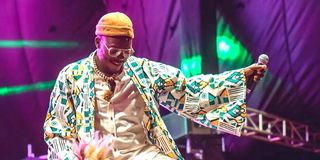
Coster Ojwang', a contemporary Luo musician and painter based in Nairobi. PHOTO | POOL
Come the ‘UhuRuto’ regime from the April of 2013, and out went this brief flirtation with our local talents, and in came the ‘Reign of the Ogas’ in vocals for around three years, swiftly followed by the craze for Tanzanian ‘Bongo’ flavor music, for another five years, with the chief ‘Bongoman’ being one Diamond Platinumz who soon became the hugest regional celebrity East Africa has seen.
Around the period of the (in) famous political handshake between Uhuru and Raila, when then DP Ruto was saying that “reggae must be stopped” (in reference to the Building Bridges Initiative), it wasn’t reggae but local music that was rising from the embers of intercontinental scorching for years from the West and East...
The live-music era of the last quarter of the last decade, mostly pioneered by cultural institutions and art spaces such as Alliance Francaise, Goethe Institute, GoDown, Kuona Trust and others- was then disrupted by the coming of Covid-19, and as those local bridges burnt here, young Kenyans used their bright flames to discover the overpowering enchantment of South Africa’s ‘Amapiano’ music.
Fortunately, a genre called ‘Gengetone,’ also from the late 2010s, had survived the cultural gangrene that was Covid-19, and without live performances, as Tik Tok took over, and ‘social media’ influencers (like Azziad) did cover dances of local songs – most famously Femi One and Mejja’s Utawezana, the year after corona was one long Corona (the beer) celebration in song.
Most youthful anthems were dedicated to alcohol (pewa! lewa!!) – so that into this liquid and lyrical expressionism, even though a General Election year loomed into view into 2022, politically reactive music – through foreign African influences across a decade, through an epidemic, through digitalisation, and an ‘escape to feel good’ new Genge ‘Z’ mentality – felt, and still feels, lost in the ether of nowhere.
The notable exception was Xray Taniua (featuring popular youngings Trio Mio and Ssaru) with SiPangwi’ngwi, and even that was a social song bought for political purposes, as was the alchemisation of Furaha by Iyanii to attract the youth vote to a particular alliance.
Although national interest in vernacular and folk music from different communities across the country has generally sparked up, one of the biggest beneficiaries is Luo music, as we enter 2024, in spaces that sometimes feel politically post-apocalyptical.
Tony Mochama is the author of ‘ Nairobi, the Night Runner’s Guide to the Nocturnal City in the Sun. [email protected]

